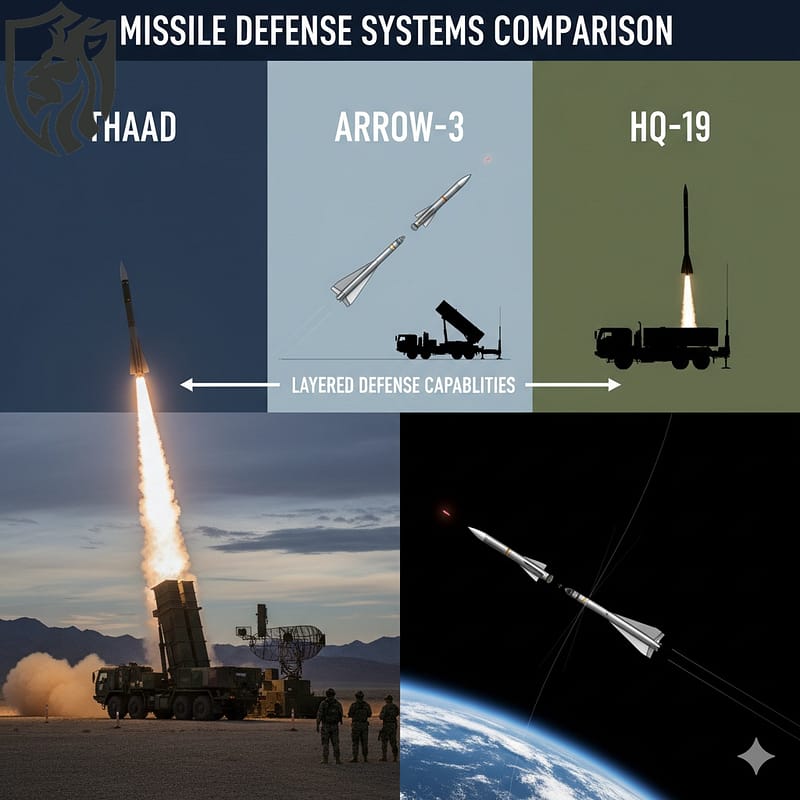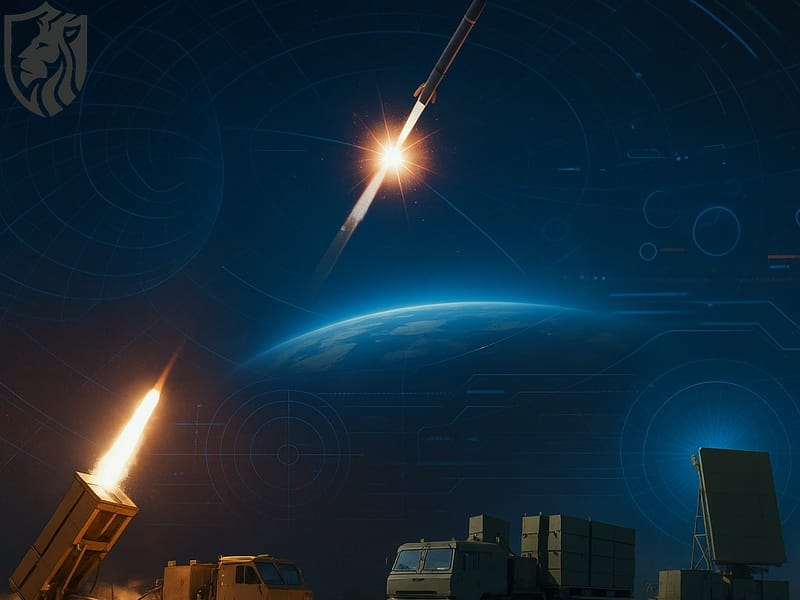
THAAD vs Arrow-3 vs HQ-19 — No System Is 100%
Bottom line up front
No, THAAD vs Arrow-3 vs HQ-19 can slash risk, but none can promise a 100% stop—especially under salvos, countermeasures, and imperfect sensor coverage. Warfare is a probability game. Commanders stack layers, shots, and sensors to drive expected damage low—not to chase an unattainable zero-leak outcome. This framing sets the context for THAAD vs Arrow-3 vs HQ-19 in any credible analysis.
What the record really shows
THAAD (United States)
THAAD’s formal intercept test record is near-perfect in controlled trials: 17 successes in 17 dedicated intercept tests. That proves hit-to-kill physics works as engineered. However, tests ≠ combat. THAAD’s first confirmed combat kill came in the UAE in January 2022 against a Houthi ballistic missile—a valuable proof point, yet a small wartime sample. These facts matter when comparing THAAD vs Arrow-3 vs HQ-19.
Arrow-3 (Israel)
Arrow-3 has executed multiple exo-atmospheric operational interceptions since late 2023, including against long-range missiles fired from Yemen. During Iran’s April 2024 mass strike—with >300 inbound drones and missiles—Israel and partners downed the vast majority. Impressive, yes; absolute, no. Operational layering, not a single system, delivered those results—another key nuance in THAAD vs Arrow-3 vs HQ-19 discussions.

HQ-19 (China)
HQ-19 is broadly analogous to THAAD in midcourse/terminal roles. China has repeatedly announced successful land-based midcourse ABM tests over the past decade. Open operational data remain sparse, and doctrine details are limited. Transparency is the core constraint when analysing THAAD vs Arrow-3 vs HQ-19 performance.
The wider U.S. hit-to-kill picture
Across U.S. programmes (THAAD, Aegis BMD, GMD, PAC-3), open tallies show 88 successes in 107 attempts. That is strong engineering, but not 100%. Tests occur under known timelines and geometries; wars are messier—an essential caveat for THAAD vs Arrow-3 vs HQ-19 expectations.
Why “100%” is a myth
1) Physics and geometry
Interception windows are brutally short. Midcourse shots occur in space; terminal shots happen in the last tens of seconds of re-entry. Tiny changes in trajectory, apogee, or speed can push threats outside an interceptor’s kinematic envelope or radar look angles. States therefore layer systems—Arrow-3 over Arrow-2/David’s Sling/Iron Dome; THAAD overlapping with Patriot. Even then, no geometry is perfect—crucial when weighing THAAD vs Arrow-3 vs HQ-19.
2) Countermeasures and complexity
Modern ballistic missiles may carry decoys, chaff, or manoeuvring re-entry vehicles (MaRVs). Discriminating a small, cold warhead from sophisticated decoys in midcourse is hard, even with space-based cueing and large radars. The attacker needs only one leaker. This is central to realistic THAAD vs Arrow-3 vs HQ-19 planning.
3) Salvos, saturation, and magazine depth
Defenders often fire two (sometimes three) interceptors per threat (“shoot-look-shoot”) to stack probabilities. But magazines are finite, reloads are slow, and C2 bandwidth is limited. Large raids—like April 2024—force prioritisation (cities and bases first). “Very high” stop rates are not 100%. Thus, THAAD vs Arrow-3 vs HQ-19 must be judged alongside stockpiles and logistics.
4) Cost-exchange problem
Interceptors are expensive. Representative open estimates put THAAD interceptors at ≈ $12–13 million each and Arrow-3 at ≈ $3–4 million. Attackers can launch more, cheaper threats or add decoys to drain magazines. Over time, economics erodes the pursuit of perfect defence—another practical lens on THAAD vs Arrow-3 vs HQ-19.

5) Real-world friction
Combat brings fog and friction: maintenance gaps, mis-cues, comms latency, weather, and blue-force deconfliction. One missed track handoff can equal one leaker. That is why operators plan in layers, not absolutes—especially when fielding THAAD vs Arrow-3 vs HQ-19 together with allies.
System-by-system snapshot
THAAD
- Role: Terminal/endo-exo edge; MRBM/IRBM class threats.
- Envelope: ~200 km class engagement range; up to ~150 km altitude.
- Record: 17/17 formal intercept tests; limited but positive combat sample (UAE, Jan 2022)
- Strengths: Proven hit-to-kill physics; high endgame energy; mobile flexibility.
- Limits: Magazine depth; unit cost (≈ $12–13 m per interceptor); reliance on high-fidelity cueing and favourable geometry.
- These specifics anchor where THAAD vs Arrow-3 vs HQ-19 diverge in doctrine and costs.
Arrow-3
- Role: Exo-atmospheric “space kill” for long-range ballistic missiles.
- Operations: Multiple real engagements since late 2023; integrated within a layered Israeli shield (Arrow-2, David’s Sling, Patriot, Iron Dome)
- Strengths: Early, high-altitude engagements; cleaner debris footprint; potential second-shot opportunities.
- Limits: Not perfect against complex salvos/countermeasures; magazine and cost pressures in sustained campaigns (≈ $3–4 m per interceptor)
- This feature underscores how THAAD vs Arrow-3 vs HQ-19 trades altitude against volume and stockpile realities.
HQ-19
- Role: Midcourse/terminal ABM; often credited with potential ASAT-adjacent roles.
- Tests: Multiple publicly announced midcourse successes in the last decade.
- Strengths: Fits within China’s broader A2/AD sensor-shooter web.
- Limits: Sparse open data on discrimination vs sophisticated decoys and manoeuvring RVs; unclear operational stockpiles.
- These unknowns shape impartial comparisons in THAAD vs Arrow-3 vs HQ-19 analyses.
The probability reality (why commanders fire two)
- Treat each interceptor as having a single-shot kill probability (SSKP) < 1. If SSKP ≈ 0.8 (illustrative), two shots yield 1 – (1 – 0.8)² = 96%; three shots ≈ 99.2%. That looks near-perfect. Yet scale matters.
- Against 20 inbound missiles, even 96% per target implies ≈ 0.8 expected leakers. Large raids push that expectation higher.
- Consequently, you see layered geometry, multiple shooters, and dual-shot doctrine across THAAD vs Arrow-3 vs HQ-19 deployments.

“The parts people skip”
Stockpiles, not specs, often bind first. In extended crises, resupply tempo and industrial surge capacity dominate outcomes. Perfect defence can break budgets before it breaks physics. This is a decisive variable when gaming THAAD vs Arrow-3 vs HQ-19 for months-long contingencies.
Discrimination drives everything. The most decisive “weapon” is frequently the sensor stack and algorithms that tell you which dot in space is the warhead. Investments in radar/software and allied cueing can produce larger real-world gains than marginal interceptor kinematics—vital context for THAAD vs Arrow-3 vs HQ-19 improvement plans.
Layering is doctrine, not a slide. Exo-atmospheric shots (Arrow-3) thin the herd early; endo-atmospheric shots (THAAD/Patriot) mop up; other systems counter cruise/loitering threats. April 2024 worked because layered networks plus partners shared tracks and shots. No single element in THAAD vs Arrow-3 vs HQ-19 carried the day.
Conclusion
THAAD vs Arrow-3 vs HQ-19 can dramatically reduce risk from ballistic missiles—but none can promise 100%. Real defence is probabilistic, shaped by layers, sensors, SSKP-stacking, magazine depth, resupply cadence, and the attacker’s ingenuity. The smartest planners don’t chase “perfect.” They build resilient, layered, replenishable shields that keep expected damage acceptably low—even on the worst night.








